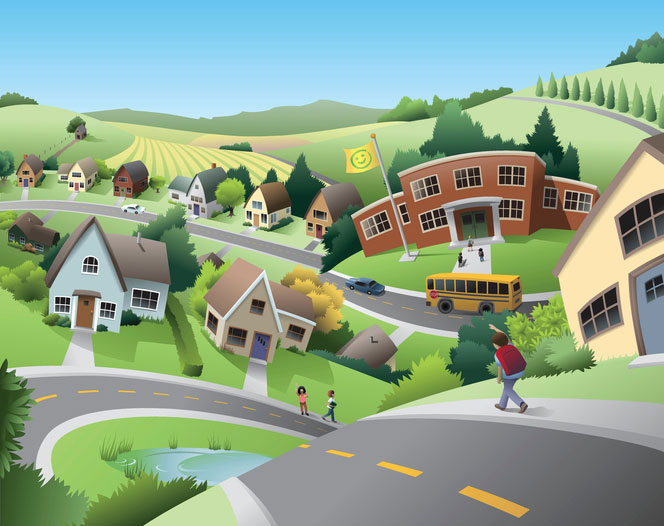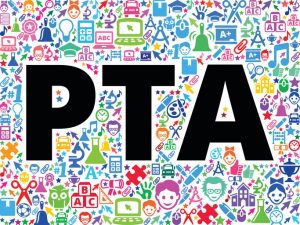7 Reasons You Have the Best Community for Education
8/16/2018

What makes some communities better than others for education? Much like creating the perfect pizza with cheese, meat, and vegetables, successful communities have the right mix of ingredients. One person may be able to correctly put these ingredients together, but a team can do it more effectively and efficiently. These teams must include school employees, parents, business partners, and other community members.
How do you know your community is successful at educating students? High achievement data that shows growth for all students is one characteristic of a successful school. Hopefully, achievement data isn't the only deciding factor you are using to rank its success. I believe creating students that are kind, compassionate, and tolerant of others should be equally as important. The focus of this article is the "hidden curriculum," the others factors besides academics that sets schools apart. Though these aspects of the hidden curriculum are difficult to quantify, I believe every successful community has seven factors that set them apart from others.
- Positive School Culture with Strong Leadership
- Strong Business and Community Partnerships
- Active PTA/PTO's
- High Volunteerism, Even without Immediate Stakeholders
- School's Impact Reaches Outside of the Area (even State, or Country)
- Finds Funding Solutions
- Positive Stories Outweigh the Negative

1 - Positive School Culture with Strong Leadership
Bill Daggett, Founder of the International Center for Leadership in Education, states that when he researched the top achieving schools in America, the top 1% of the top 1%, they all had one thing in common, a positive school culture. He further declares that when you walk into these schools you know right away that there is something intangible about these learning environments.
Creating a positive school culture doesn't happen overnight. It takes strong leadership and a desire to make every decision based around students. It doesn't matter if it is the crossing guard or the superintendent, how staff members treat people, and more specifically, students, sets these schools apart. They strive to create an environment that nurtures students and celebrates those with a growth mindset.
In earlier blogs on culture, specifically 212 Degrees of Customer Service in Education, I have talked about a 5-minute walk through. In the first five minutes of a visit, what does a brand new community member experience in your school? Here are a couple examples one might see in a successful school's 5-minute walk through:
- Interactions between Staff and Community Members - A community member should be acknowledged in their first five minutes in the school building by a staff member. Acknowledgement means a greeting or possibly giving directions on where to check into the main office. Possible words might sound like the following, "May I support you?" Many schools use stickers or badges that state, "visitor" or "volunteer." If they have a sticker or badge, a simple greeting my raising your head from the ground (or mobile device) is sufficient. Possible words might sound like the following, "Good Morning" or "Go, Cubs!"
- Staff to Staff Interactions - Watching how staff treat each other may seem nonessential to understanding a school's culture, but this is quite the opposite. How staff treat each other sets the tone for how parents, community members, and students will be treated while on campus. If staff acknowledge each other with positive greetings, laughter, and proactive statements, they will most likely do the same with everyone else. Making this an expectation in the school building is not only the leadership's responsibility, but every staff member who works on campus. A great mantra to use with staff is the following, "Make this a place where you want to work and learn."
- Staff to Student Interactions - Watching how staff interact with students is also an indicator of a positive school culture. Are the words proactive and positive when correcting behavior? If they are, parents and community members can expect to be treated in the same fashion. Even when a student is having a blowout, the words and actions a staff member uses to support the student is vitally important. Do community members and staff members understand that during that 5 minute observation there is going to be some behavior problems…I sure hope so! The key is how they have been trained to deescalate and work with these difficult students. Again, this is a leadership expectation for all staff members. Some good mantra to use with staff members is the following, "Treat all students as if they were your own."
- Student to Staff Interactions - Watching how students treat staff can tell you a lot about how effective the staff is in a school. If students are given positive, proactive words, as well as tools and strategies to use when frustrated, you will find a positive school culture. The larger a student's toolbox to communicate determines how well they can express their needs. Educators must build and expand a student's toolbox. Showing respect to all adults in the school setting starts with our words, tone, and body language (especially facial expressions). When the school explicitly teaches communication schools such as those, positive interactions occur on a higher rate. Not only do we teach students how to interact when they are mad or sad, we must also teach students typical interactions for happiness. We must teach kindness, compassion, and tolerance. When students illustrate these characteristics on a daily basis, there is a higher chance of finding a positive school culture. Lastly, we must also teach students how to give and accept positive specific praise. This is the key to a happier and more pro-social learning environment. When students understand how powerful a positive specific praise statement can be to another student or staff member, this will become contagious and spread!
- Student to Student Interaction - Watching how students interact with each other tells you a lot about the school's positive culture. As anyone can guess, listening to every conversation on a school campus by staff members is impossible. In the first five minutes of a walkthrough we should see and hear a high percentage of positive and kind words and actions occurring. Are the students displaying compassion (or what I like to call empathy in action) and tolerance of each other? A lot of work from staff members, specifically teachers and leadership, goes into modeling, practicing, and implementing positive and proactive words with students in a school environment. 100% compliance is not reasonable, but checking in on ten conversations between students, we should goal for nine of those conversation to being positive.
We can learn a lot from our schools in the first five minutes. Schools can take the "5-Minute Challenge" to determine what types of interactions they do well and what they can improve. I would recommend not only having staff members complete this challenge, but also parents and community members. I would conduct these observations unannounced. I think you will learn a lot about your school culture.

2 - Strong Business and Community Partnerships
Partnerships are sometimes hard to find and nurture. There is a natural transition between a school searching for partnerships to support learning, and picking and choosing between what each partnership can bring to the table. At one end of the spectrum you are trying to get anyone to support your school, and at the other end you are picking and choosing which partnership best supports a specific facet within education. Partnerships should be a priority with every staff member.
This famine or feast condition is not only the responsibility of leadership within a district, but every level and every position within the school. We would be remiss if we didn't think a lunch lady had pull or influence with other community members or service providers. The interactions the staff members have with the community are important. We are not suggesting special favors for the school district, we are stating that our words and actions have positive and negative consequences on our partnerships.
A school that is starting to partner with businesses and organizations must nurture these relationships. When it comes down to a common goal, most of these partnerships have congruent goals: support student learning and development. Educators must work hard to maintain these relationships through communication, compromise, and celebration. Educators sometimes forget the last component, celebration…we must celebrate and thank these partnerships.
At the other end of the spectrum, some schools have many partnerships and it is difficult to manage or maintain all these relationships. They are getting student needs met by these partnerships and creating goals that are specific and measurable. An underlying premise, and assumption, for school staff should be the following: All partnerships want to know they are making a difference, and we must find ways to illustrate to them they are making a difference.
Once a school makes this transition, partnering with them becomes contagious. Everyone wants to be part of something successful. A foundation can be set up in your school…it would be a great start to making partnerships infectious!

3 - Active PTA/PTO's
Not every successful school has a strong PTA or PTO, but it sure helps. In fact, I would argue that parents and guardians are key ingredient to a high achieving school. Yes, we may have the students for over 1,000 hours each school year at school, but a parent or guardian has them for over 7,000 hours. Building capacity and a strong PTA/PTO starts with school staff.
A PTA/PTO is designed to support the learning and development of students. They may fundraise, volunteer in the school, or do a plethora of service orientated events in the school. Teachers and leadership can help drive what this looks like on a school campus. Working together, a PTA/PTO can be a powerful tool for school success. The ideas for support are endless!
If a school does not have a strong PTA/PTO I suggest getting teachers more involved at first. If the participation is lacking, teachers can be tasked with coming to the meetings and getting involved. Then, the next step would be for each teacher or staff member to bring one parent or community member. A meeting that typically might have been only two or three members can quickly turn into 20 plus individuals. The school staff must understand the importance of a strong and healthy PTA/PTO.

4 - High Volunteerism, Even without Immediate Stakeholders
Volunteerism is a concept that many might dismiss as a waste of time. How many volunteers walk through the school doors on a daily basis? Does your school track this? I suggest you start!
There are several reasons to have volunteers in our school, some are visible and some are not. We can obviously see the difference a volunteer makes by working with students and staff members. What we do not see is the impact that these volunteers may have in the community. They talk with other community members about their school experience. This may be positive or negative.
Nurturing these volunteers is vital to a school's success. If you believe in the concept, "It takes a village," then you understand as a staff member, or specifically a teacher, that you cannot be alone on an island educating your students. We must get other professionals to support the many and various needs of our students. These professionals may be skilled in reading, writing, or a specific skill. They also may be a successful in showing compassion. Some of the best volunteers are retired from their given profession and are wanting to give back to their community through service work and volunteering in schools.
Educators must put the correct people in the correct volunteer work. We must also know when the relationship between the volunteer and the school is not safe. We must guard our students from unsafe people, and we do this by knowing our volunteers extremely well!
You know you have a strong volunteer base when community members that do not have direct stake in your school's success are coming forward to support your students. This is contagious as more people want to volunteer and be part of the success story at your school. SIDENOTE: Do you think this might help when a levee is brought forth to a community? How would these volunteers vote?

5 - School's Impact Reaches Outside of the Area, State, or Country
When evaluating a teacher, the category of "exemplary" stands by itself. Very few teachers are ranked in this very top level as most are considered "proficient." Exemplary teachers not only have a direct impact on the students in their classroom, but they can affect the entire school, community, or even have an impact at the state or national level. Successful schools can do this in the same manner.
The best schools have a far reaching impact and are connected to other successful schools around the area, state, or nation. These schools search out other schools to partner with and a symbiosis of learning can occur. These schools can push each other and work to create the best learning environments for the students they serve.
Some examples of successful schools include the Ron Clark movement. I call this a movement because so much of what they believe in is surfacing in numerous schools across the nation. Teachers and administrators are creating learning environments that celebrate learning with high energy engagement much different from traditional schools. Ron Clark's school is having an impact that reaches across the nation.
A school may have their own unique strategy for encouraging students and families to attend your school. Other schools may want to learn more or replicate the ideas and strategies that your school has implemented. Sharing resources and ideas is what makes a learning community successful.

6 - Finding Funding Solutions
In successful schools, funding can be pivotal to a student's learning experiences. As educators we understand that the state and national government have routinely and systematically increased mandates. Many, if not all, of these mandates do not come with extra funding. In addition, many school districts have not been growing. They are tasked with trying to offer the same education opportunities with less money. As costs continue to rise, schools are not afforded cost of living raises. Local communities are then asked to pick up the bill for much of the educational costs in the schools. To further complicate things, tax payers, and specifically property owners, are the people footing the bill through levies that require a vote of the community.
Poverty has a direct link to student achievement and learning experiences. Though this link can be altered and is not the final determining factor of a student's success, it is significant enough to make the correlation. There is a direct correlation between achievement data and the social economic status of the community. Again, I am not saying that this statement is always true, but the probability is quite evident.
Successful schools find a way to get more funding. They tell the story of their school and communicate their goals to stakeholders, as well as community members. They increase their business partnerships and work with community members to meet the needs of the students. They also try to give students opportunities for learning experiences that the community deem important. Successful schools understand the importance of being good stewards of public tax dollars, donations, and other funding.
Successful schools also finding ways to increase student achievement without further funding. John Hattie, University of Melbourne researcher, states that teacher efficacy is the number one instructional strategy to raise student achievement (1.58 effect size). This is the ability for all staff to believe they can affect student achievement if they are all on the same page…one goal or vision…implemented successfully school-wide. This can be done with little to no funding.
When schools have to cut programs it makes difficult to offer a wide variety of learning experiences for students. Families may move. Likewise, when teachers or administrators are paid less than equivalent positions elsewhere, they may move. These schools need to continue to create efficacy in order to keep the best professionals in their school. Creating a "why" for these individuals working in your school is important, and it can be a determining factor in keeping the best educators in your community. We must also do this with our families and students. Why should they stay at your school? Build the "why!"

7 - Positive Stories Outweigh the Negative
Successful schools understand that they must be the story tellers of their student's educational journeys. They also understand that if they are not telling the story, someone else may be telling it for them. You may not like what they are saying.
These schools know they cannot compete directly with negativity. By taking negative comments on publicly, it sets the stage for further ridicule. Over time, it is more and more difficult to combat. We must spin the negativity through positivity.
A good mantra to use with staff is the following, "The loudest voice in the room is heard the best." That means we must be story tellers who find new, creative, and more effective ways to communicate the positive stories about our schools with the community and parents.
If all schools, teachers, and other staff members were able to tell their story effectively and routinely, negativity can become minuscule to the needs of the students and overall school. The impact that these schools could produce will far outweigh the news outlets such as TV, newspapers, and blogs. You ask, when did schools become news agencies? The successful schools are already doing it so they can tell a more accurate picture of what is going on in their schools. This may seem like self-promotion to some, but we are competing to keep the students and families we have, as well as attracting more.
It is hard to find a successful school that does not have all seven facets listed above. Evaluate your school and determine the needs. If you have growth mindset, there is always something your school can be working towards to increase the positive school culture.
What do you believe is missing from this list?
- Learning How to Say No and Set Boundaries with Parents - November 21, 2022
- If You Had Only One Behavior Strategy to Use in Your Classroom, What Would It Be? - September 26, 2022
- Live Your Code: 7 Strategies That Will Help You Be the Most Effective Educator You Can Be - August 15, 2022











